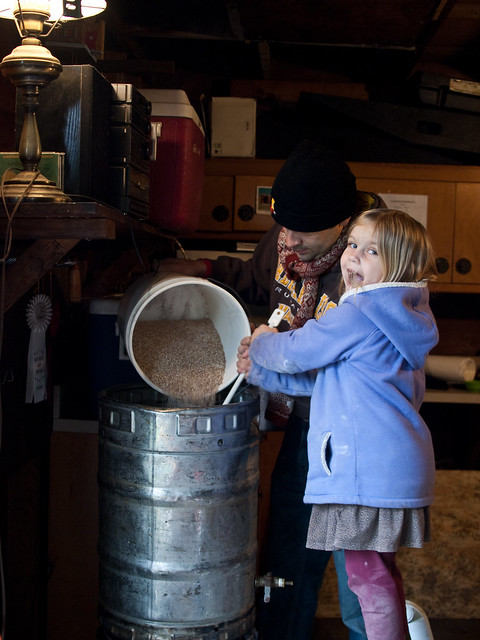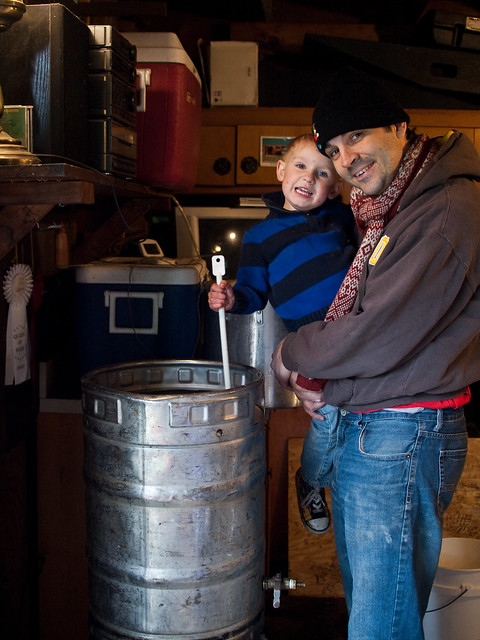Brew day: Step Leader Hefeweizen
 The next month is gonna be crazy busy for us. A trip to Brooklyn, Mother's Day, Beerfly Alleyfight, a wedding, Memorial Day weekend... There's not a free weekend day in sight. So with that in mind, I decided to take advantage of our last weekend staying at home for the next month by brewing up a quick batch of Hefeweizen. Now we've brewed our Step Leader Hefeweizen plenty of times. Our first beer ever was an extract batch of Hefe, and we even brewed a Hefe to hand out when our third child, Lily, was born. However, this time I was ready to take the next step and use a direct-fire mash tun to do an authentic, Bavarian-style mash schedule.
The next month is gonna be crazy busy for us. A trip to Brooklyn, Mother's Day, Beerfly Alleyfight, a wedding, Memorial Day weekend... There's not a free weekend day in sight. So with that in mind, I decided to take advantage of our last weekend staying at home for the next month by brewing up a quick batch of Hefeweizen. Now we've brewed our Step Leader Hefeweizen plenty of times. Our first beer ever was an extract batch of Hefe, and we even brewed a Hefe to hand out when our third child, Lily, was born. However, this time I was ready to take the next step and use a direct-fire mash tun to do an authentic, Bavarian-style mash schedule.When it comes to heating mashes, there are all sorts of acronymed methods you can employ (RIMS, HERMS, etc.). However, I've read that if you're using a mash tun that can be direct-fired, you can keep your mash temperature fairly consistent by simply pumping the wort out the outlet valve and back up to the top of the mash using a hose. I decided to try this simple method and see what happens. As for the mash schedule, well it was right out of Eric Warner's Classic Beer Style series book, German Wheat Beer: mash in around 100°F, direct heat it to 122°F for a 25-minute rest, decoct roughly two gallons for a half hour, return that to get the mash up to around 147°F, let it sit there for 15 minutes, direct heat it to 160°F for 15 minutes, then direct heat it to 170°F for the mash-out.
 |
| Dorrie helps mash in... |
 |
| ...and Jonas helps stir the mash. |
I did a 90-minute boil and ended up collecting 4.6 gallons of Hefe at 1.069 (yes, still trying to dial in my evaporation rates) which I diluted to 5.6 gallons at 1.053. I aereated and pitched a 500mL starter of WLP 380 Hefeweizen IV yeast. Unfortunately, my chest freezer had previously been set to 34°F and while I left it open for a little while it apparently was still quite cold because 18 hours later there was still no fermentation and when I took a temperature reading it was at 59°F. My plan was to start at 62°F and up it two degrees each day to 68°F.
I left the chest freezer open for most of the evening and fermentation began about 24 hours after pitching at 60°F. This morning it was up to 62°F (which the chest freezer thermostat was still set to) but now it's already up to 66°F! So much for my plan of slowly ramping up! Oh well, I guess we'll see what kind of flavor profile we get out of it. I'll do my best to post the results here down the road (yeah, I know I always say that but tend to forget to actually do it).
In the meantime, I kegged our light and dark mild ales last night and carbed them tonight. They're quite tasty, though I'm not finding that big of a difference in flavor between the light and dark milds. I'm thinking next time, instead of chocolate and carafa malts I'll go with chocolate and roast barley. Fortunately, they're both damn tasty! Cheers!




